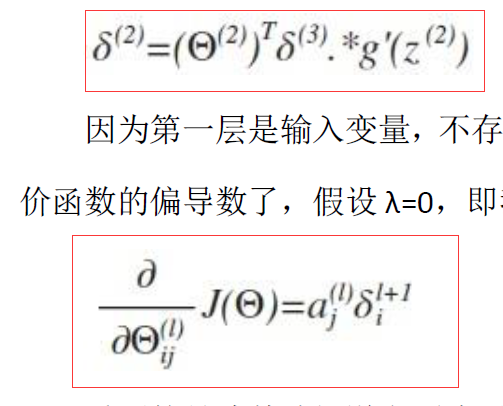关键就在偏导数计算这两行,两行合并起来就是完整的误差传导公式,梯度检验也是正确的,但训练正确率一直没有提高,当去掉第二行时,训练就成功了,不过不符合公式,不知道到底哪里出了问题。
delte2=theta2_non'*delte3;%第二层误差,行
delte2=delte2.*a2(2:end,:).*(1-a2(2:end,:));%完全版误差公式
clc;clear;
%============初始化================
x=[ 1, 2,-3,-4,-5,-2, 2,2;...
-1,-2,-3,-4, 5, 2, 3,4;...
1,-2, 3,-4, 5,-3,-3,1];
y=[1,1,0,0,0,0,0,0;...
0,0,0,0,0,0,1,1;...
0,0,1,1,1,1,0,0];
x_e=[-1.5, 3,2,-5,-1;...
7,-1,1,-1,2;...
6, 0,0,-2,1];
x_e_label=[0,1,0,0,0;...
0,0,1,0,0;...
1,0,0,1,1];
m=length(y(1,:));
alpha=1;
lamda=0.02;%正则化参数
theta1=(rand(3,3)-0.5)/10;%参数初始化,范围在-0.05~0.05之间,三行三列
theta2=(rand(3,4)-0.5)/10;
a20=1;%偏置不变
%theta1,2为第一二层参数,第三层没有,dtheta1,2为第一二层参数的偏导数容器
%a1为特征,数值偏离1,a2,3都是激活过后的数值,在1附近
%delte2,3为各层误差值
%============初始化================
%============总循环================
for q=1:500
J=0;
delte2=zeros(3,1);
delte3=zeros(3,1);
dtheta1=zeros(3,3);
dtheta2=zeros(3,4);%每次更新对偏导数置零
correct_num=0;
%========= %计算平均偏导数循环===========
for i=1:m
a1=x(:,i);%取每列特征数据
z1=theta1*a1;%列
raw_a2=1./(1+exp(-z1));%s激活函数
a2=[a20;raw_a2];%添加偏置a20,列
z2=theta2*a2;%1列
a3=1./(1+exp(-z2));
%y(:,i)-a3第三层误差,列
delte3=y(:,i)-a3;
theta2_non=theta2(:,2:4);
delte2=theta2_non'*delte3;%第二层误差,行
delte2=delte2.*a2(2:end,:).*(1-a2(2:end,:));%完全版误差公式
dtheta1=dtheta1+delte2*a1';%偏导数计算完成,但尚未进行平均,后面的是矩阵
dtheta2=dtheta2+delte3*a2';
J=J+y(:,i)'*log(a3)+(1-y(:,i)')*log(1-a3);%小代价函数
end
%========计算平均偏导数循环============
g_check=gradient_check(theta1,theta2,x,y)%梯度检验
dtheta1
dtheta2
%========代价函数和梯度下降============
J=-J/m;%+lamda/2/m*(sum(sum(theta1.^2))+sum(sum(theta2_non.^2)));%完整代价函数
theta1=theta1+alpha*dtheta1/m-lamda/m.*theta1;%加入正则化的梯度下降
temp_theta2=theta2;
temp_theta2(:,1)=0;%偏置theta不加入正则化计算,故单独拿出来
theta2=theta2+alpha*dtheta2/m-lamda/m.*temp_theta2;
fprintf('循环%d,代价函数为:%0.4f,',q,J)
%========代价函数和梯度下降============
%========训练集验证====================
for i=1:length(y(1,:))
a1=x(:,i);%取每列特征数据
z1=theta1*a1;%列
raw_a2=1./(1+exp(-z1));%s激活函数
a2=[a20;raw_a2];%添加偏置a20,列
z2=theta2*a2;%1列
a3=1./(1+exp(-z2));
train=[y(:,i),a3];
[~,i1]=max(y(:,i));
[~,i2]=max(a3);
if i1==i2
correct_num=correct_num+1;
end
end
fprintf('训练集正确率:%0.1f\n',correct_num/length(y(1,:))*100);
%========训练集验证====================
end
%============总循环===========================
%============训练完成后进行测试集验证=======
correct_num=0;
for i=1:length(x_e(1,:))%测试集验证
a1=x_e(:,i);%取每列特征数据
z1=theta1*a1;%列
raw_a2=1./(1+exp(-z1));%s激活函数
a2=[a20;raw_a2];%添加偏置a20,列
z2=theta2*a2;%1列
a3=1./(1+exp(-z2));
test_set=[x_e_label(:,i),a3];
[~,i1]=max(x_e_label(:,i));
[~,i2]=max(a3);
if i1==i2
correct_num=correct_num+1;
end
end
fprintf('测试集正确率:%0.1f\n',correct_num/length(x_e(1,:))*100);
%============训练完成后进行测试集验证=======
以下是梯度检验
function gradient_check=gradient_check(theta1,theta2,x,y)
eps=0.001;
a20=1;
temp_gradient_check=zeros(1,21);
for temp_i=1:21
temp_theta1=theta1';%先转置,再展开,对单个参数处理,塑形,再转置
temp_theta2=theta2';
unrolled_parameter=[temp_theta1(:);temp_theta2(:)]';%参数展开
unrolled_parameter(temp_i)=unrolled_parameter(temp_i)+eps;%加一点参数
temp_theta1=reshape(unrolled_parameter(1:9),3,3);
temp_p_theta1=temp_theta1';
temp_p_theta2=reshape(unrolled_parameter(10:21),4,3);
temp_p_theta2=temp_p_theta2';
unrolled_parameter(temp_i)=unrolled_parameter(temp_i)-2*eps;%减一点参数
temp_theta1=reshape(unrolled_parameter(1:9),3,3);
temp_n_theta1=temp_theta1';
temp_n_theta2=reshape(unrolled_parameter(10:21),4,3);
temp_n_theta2=temp_n_theta2';
J=0;
for i=1:length(y(1,:))
a1=x(:,i);%取每列特征数据
z1=temp_p_theta1*a1;%列
raw_a2=1./(1+exp(-z1));%s激活函数
a2=[a20;raw_a2];%添加偏置a20,列
z2=temp_p_theta2*a2;%1列
a3=1./(1+exp(-z2));
J=J+y(:,i)'*log(a3)+(1-y(:,i)')*log(1-a3);%小代价函数
end
J_p=J;
J=0;
for i=1:length(y(1,:))
a1=x(:,i);%取每列特征数据
z1=temp_n_theta1*a1;%列
raw_a2=1./(1+exp(-z1));%s激活函数
a2=[a20;raw_a2];%添加偏置a20,列
z2=temp_n_theta2*a2;%1列
a3=1./(1+exp(-z2));
J=J+y(:,i)'*log(a3)+(1-y(:,i)')*log(1-a3);%小代价函数
end
J_n=J;
temp_gradient_check(temp_i)=(J_p-J_n)/2/eps;
end
temp_check=reshape(temp_gradient_check(1:9),3,3);
gradient_check=[temp_check',reshape(temp_gradient_check(10:21),4,3)'];
